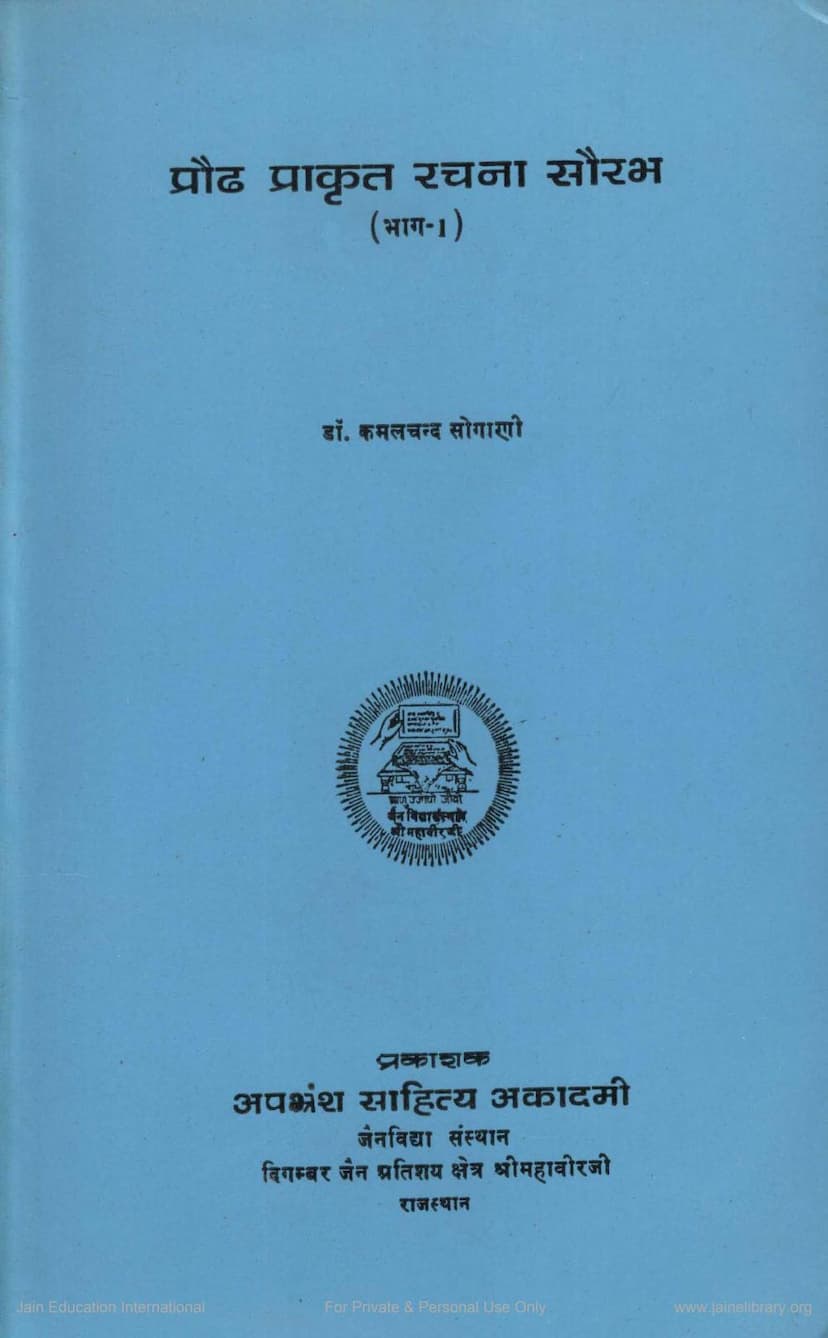Praudh Prakrit Rachna Saurabh Part 1
Added to library: September 2, 2025

Summary
This document is a comprehensive summary of "Praudh Prakrit Rachna Saurabh Part 1" (प्रौढ प्राकृत रचना सौरभ भाग-1), authored by Dr. Kamalchand Sogani and published by Apbhramsa Sahitya Academy. The book is a detailed guide to Prakrit grammar, specifically focusing on nominals (nouns and pronouns) and numerals, with an emphasis on the Shauraseni Prakrit dialect.
Here's a breakdown of the key aspects covered in the book, based on the provided pages:
1. Introduction and Purpose:
- The book is dedicated to Prakrit language learners, aiming to provide specific knowledge of Prakrit grammar.
- It highlights Lord Mahavir's preaching in the vernacular Prakrit, making spiritual and philosophical concepts accessible to the masses.
- The publication is under the 'Apbhramsa Sahitya Academy' operated by the 'Janvidya Sansthan' at the Digamber Jain Atishay Kshetra Shri Mahavirji, Rajasthan.
- The book follows in the lineage of previously published works by Dr. Sogani, such as "Prakrit Rachna Saurabh" and "Prakrit Abhyas Saurabh," intended to boost Prakrit studies.
2. Grammatical Foundations:
- The book explains Prakrit grammar through Sanskrit sutras, following the methodology of Sanskrit grammar.
- It emphasizes that a deep knowledge of Sanskrit is not required; even a basic understanding of Sanskrit grammar or grammar in any language (like Hindi or English) can be helpful.
- A crucial point is that Prakrit has only two numbers: singular and plural.
- The book introduces the Sanskrit case endings (pratyaya-sanketa) for singular and plural, outlining their usage and declension patterns, drawing parallels to Sanskrit roots like Hari, Bhubhrit, Gopa, Rama, Stri, Guru, Matri, Rajjan, Praltman, Namann, Pitri, Kartri, and Puns.
3. Structure of the Book:
- The text is systematically presented through five stages for understanding the sutras:
- Sandhi Vicched (Syllable Separation): Breaking down compound words in the sutras.
- Vibhakti Nirdesh (Case Identification): Identifying the case of words used in sutras.
- Shabdarth (Word Meaning): Providing the literal meaning of words.
- Poorn Arth (Complete Meaning): Explaining the full sense of the sutra in context.
- Prayog (Usage): Illustrating the application of the sutras.
- The book includes detailed appendices:
- Appendix 1: Sandhi rules used in the sutras.
- Appendix 2: Grammatical analysis of the sutras.
- Appendix 3: Translation of exercise sentences from Lesson 4.
- It also covers numeral declensions and ordinals, with exercises.
4. Core Content - Sutra Exposition (Nominals and Numerals): The book meticulously analyzes sutras related to:
-
Nominal Declension (Sanga-Shabdroop):
- Masculine Nouns: Dev, Hari, Gamani, Sahu, Swayambhu.
- Neuter Nouns: Kamal, Vari, Madhu.
- Feminine Nouns: Kaha, Maya, Mati, Lakshmi, Dhenu, Bahu.
- Irregular Declensions: Covers unique forms for words like Piu (father), Pipara, Kattu (doer), Appa/Prat, Appanah, Attanah, Raya/Rama, Rayanah.
-
Pronoun Declension (Sarvanam-Shabdroop):
- Masculine Pronouns: Sarva, Tat, Yat, Kim, Etad, Idam, Amuka, Anya.
- Neuter Pronouns: Sarva, Tat, Yat, Kim, Etad, Idam, Amuka, Anya.
- Feminine Pronouns: Sarva, Tat, Yat, Kim, Etad, Idam, Amuka, Anya.
- Dual Gender Pronouns: Tushma, Asmad.
-
Numeral Declension (Sankhyavachak Shabdroop):
- Cardinal Numbers: From 1 to 100, and beyond (e.g., Saha-stra, Laksha, Kodi).
- Ordinal Numbers: Construction of ordinal numbers from cardinals.
- Usage of numerals: Explains how numbers are used in sentences, including agreement with nouns and the formation of compound numbers.
5. Key Prakrit Grammatical Features Highlighted: Throughout the sutra analysis, the book details various phonetic and grammatical changes specific to Prakrit, especially Shauraseni, such as:
- Vowel and consonant changes.
- Specific rules for the declension of different noun and pronoun stems (e.g., akaranta, ikaranata, ukaranata).
- The formation of plural, dual (where applicable in Sanskrit parallels), and case endings.
- The interplay of sandhi and case endings in forming Prakrit words.
- The absence of the dual number in Prakrit.
- The interchangeability of certain case endings (e.g., Chaturthi and Shashti, Dvitiya and Trutiya with Saptami).
- The specific rules for pronouns like Kim, Yat, Tat, Idam, Etad, Amuka, Anya, Tushma, and Asmad.
- Detailed declensions for numerical adjectives.
6. Scholarly Contribution:
- Dr. Kamalchand Sogani, a retired Professor of Philosophy, brings his extensive knowledge to this work.
- The book is a valuable resource for students and scholars of Prakrit, offering a methodical approach to understanding its grammar based on classical Indian linguistic traditions.
In essence, "Praudh Prakrit Rachna Saurabh Part 1" is a rigorous academic text designed to equip learners with a solid foundation in Prakrit nominal and numerical grammar, presented through clear explanations of ancient sutras and comprehensive paradigms.